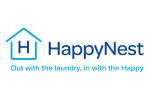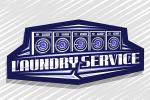OAKBROOK TERRACE, Ill. — Two laundry business operators who offer wash/dry/fold pickup and delivery services described their delivery fleets and addressed some of the challenges involved in maintaining them during a recent Coin Laundry Association webinar.
In “Pickup and Delivery: Managing Your Fleet,” Beck Miller, director of franchise operations for Laundrolab based in Charlotte, North Carolina, and Travis Unema, who owns Brio Laundry in Bellingham, Washington, detailed their respective operations and suggested best practices for acquiring and maintaining the vehicles that their pickup and delivery efforts depend upon.
Unema’s business utilizes a box truck and a minivan. The box truck typically handles larger, custom commercial laundry, while the minivan serves a mix of residential and small-business laundry accounts.
Drop-off is at two locations: Brio Cleaners (“Think of an on-premise laundry,” he says) and the Brio retail laundromat. Between the two vehicles, Brio Laundry employs four to six drivers, on average. One works full-time, the rest part-time. Deliveries are daily Monday through Saturday.
“Managing that does take time to do the maintenance on the tires, the fueling and the gas part when you have six people sharing two vehicles,” Unema says. And learning the disparate accounts “does take some time for the drivers, where to go to each location and where to drop off the laundry when they pick it up.”
Miller says the largest Laundrolab operation is in Charlotte, where 16 vans are used for pickup and delivery, with 14 or 15 on the road on any given day: “We keep a couple in reserve should another vehicle need maintenance or go down for repairs so we don’t hinder our ability to service all of our customers.”
Pickups are done between roughly 9 a.m. and 1 p.m. as drivers gather all the dirty clothes left by customers for scheduled pickups and transport them to a cleaning facility.
“Most drivers only go to one Laundrolab, but we do have multiple in the Charlotte market,” Miller says. “Certain drivers will go to one, certain drivers will go to another, whichever one is closer. And they’ll also go to our drycleaning partners. We don’t do any of the dry cleaning in-house. We have a relationship from a wholesale standpoint with drycleaning vendors.”
After dropping off the dirties, the drivers pick up the clothes that were cleaned the previous day and deliver them to customers. That takes up the latter half of their day, until 5 or 6 p.m. Laundrolab operates on a one-day turnaround, with pickups Monday through Friday and deliveries Tuesday through Saturday.
CHOOSING THE STYLE
How did you select the vehicle types? Were cost, size and safety all considerations? And might aftermarket modifications be needed?
“For our residential (work), we just used what was available,” Unema says. “We use a 2016 Dodge Caravan minivan. It gets good mileage. It can haul a lot for its space. Relatively cheap to fix. Tires are pretty cheap on it, and it’s easy to modify.”
Other than adding some decals for advertising, Brio removed the seats, put in carpeting and installed a drycleaning products bar, which also prevents laundry bags from tipping over. “It’s almost like a support down the middle,” he adds.
The other vehicle is what Unema describes as a “fairly small” box truck purchased out of necessity to serve Brio’s commercial accounts.
“We have to service laundries inside facilities like hospitals and other stuff,” he explains. “For that amount of laundry, you can’t carry bags, and bags will rip. You’ve got to go up and down elevators, so you need to have trolleys. And a lift gate for backing up that can go up and down.”
The box truck gets lower mileage than the Caravan, maintenance is a bit harder, and utilizing it requires a lot more driver training, he adds.
Laundrolab uses predominantly Transit Connects, Miller says, because when the franchise started getting into pickup and delivery around 2016, it was the best option “based on the intersection of cost, size, and how many pickups we needed it to do on any given route. Our drivers are going to be doing between 20 and 30 pickups, so the capacity is there to hold all the laundry that we need.”
A lease structure was established to cycle through the Connects every few years.
“With how supply chain issues have been over the past year, we’ve kind of expanded out of that and added some Dodges to the fleet, because it’s kind of a take-what-you-can-get environment because of shortages across a lot of that stuff.”
Laundrolab also utilizes a hanging bar in each of its Connects, but not a vertical drycleaning rack that would extend all the way to the rear of the van. “Instead, we do a horizontal bar that goes behind where the driver and passenger seat is and that’s where we load up our dry cleaning or any hang-dry orders, then we have a separator behind that where all the bags for wash/dry/fold go.”
DON’T LET LITTLE THINGS BECOME BIG PROBLEMS
Can you share some of your best practices for managing your fleet?
“The biggest thing is just keep up with (the maintenance),” Miller says. “Little things can compound and turn into big things very quickly if you aren’t actively monitoring all of your maintenance with the vans. Like doing your oil changes and all that sort of routine maintenance that you would do on your own, personal car. It’s easy to accidentally let that get away from you if you’re not the one driving that van.”
There is software available to help with tracking. You can use Google Sheets, an Excel spreadsheet, or even paper and pencil works, he says.
“There just needs to be something there that you are staying on top of that stuff with so you don’t run into the really large issues after something’s been sitting for a long time.”
Brio stages what Unema calls “Maintenance Mondays,” when drivers utilize a special checklist while examining their vehicle.
“One of the things noted on there is ‘Are there any lights on or anything abnormal?’ I do my best to listen to my drivers, they’re the ones driving the vehicle. Trying to get them to explain—‘Hey, what’s going on with the vehicle?’—is important because then you can do the maintenance on it. ... Preventive maintenance is the key. Otherwise, you’re a vehicle down and you’ve got to find somewhere to rent to cover while yours is getting repaired.”
Check back Thursday for the conclusion!
The Coin Laundry Association frequently offers webinars that cover topics such as marketing, store operations and management, and new investor education. Visit www.coinlaundry.org/events/webinars to learn more.
Have a question or comment? E-mail our editor Bruce Beggs at [email protected].


















